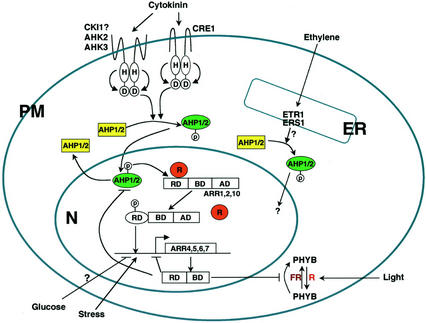Figure 9.
Model of the two-component signal transduction pathways in Arabidopsis. The cytokinin signal is perceived by multiple His protein kinases at the plasma membrane. Upon perception of the cytokinin signal, His protein kinases initiate a signaling cascade via the phosphorelay that results in the nuclear translocation of AHPs (Hwang and Sheen, 2001). Activated AHPs may interact with sequestered ARRs or ARR complexes, transfer the phosphate to the receiver domain of its cognate B-type ARR, releasing these activation-type ARRs from putative repressors in the nucleus. The dephosphorylated AHP shuttles back to the cytosol, where it can be rephosphorylated. The liberated ARRs bind to multiple cis elements in the promoter of target genes. The activation of the repressor-type ARRs as primary cytokinin response genes provides a negative feedback mechanism. In addition to the CTR1 signaling pathway, additional ethylene signaling pathways could be mediated by two-component components (Lohrmann and Harter, 2002). Red light and cytokinin signaling is converged at ARR4. ARR4 stabilizes the active form of PHYB by inhibiting dark reversion (Sweere et al., 2001). Stress and Glc may also modulate two-component signaling (Urao et al., 1998; F. Rolland and J. Sheen, unpublished data). RD, Response domain; BD, DNA binding domain; AD, transactivation domain; PM, plasma membrane; N, nucleus; R, putative repressor; FR, far-red light.

